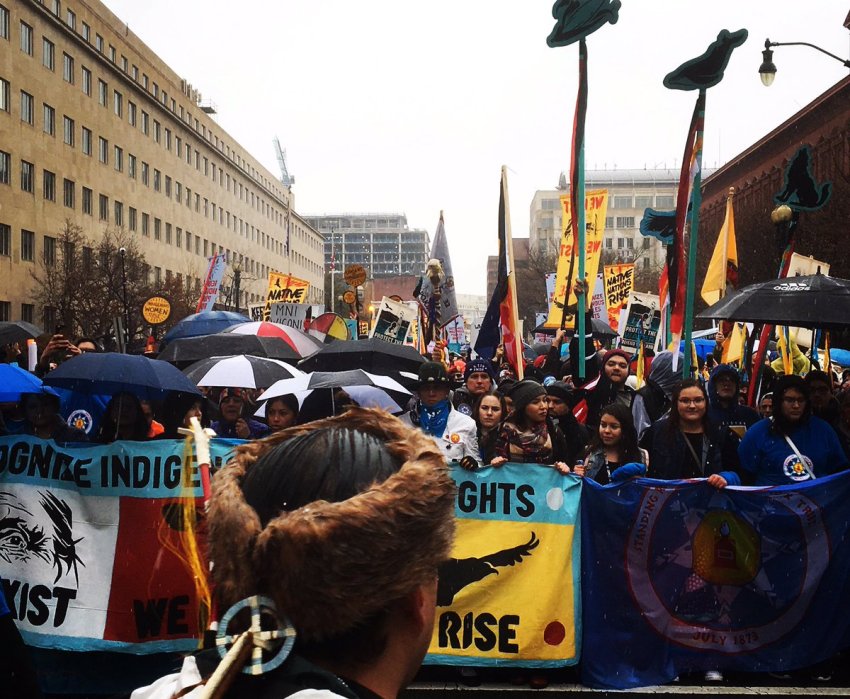
“Water is life!” was the cry heard throughout Washington, DC on March 10 as thousands of people marched for Indigenous rights and the sovereignty of native nations, Common Dreams said that day.
The Native Nations Rise march demonstrated that the fight against the Dakota Access Pipeline (DAPL) has sparked an ongoing movement.
The fight against DAPL, which threatens Native land and water supply at Standing Rock Indian Reservation in North Dakota, has brought together hundreds of First Nations in the biggest united indigenous struggle in North America for decades.
The scale of resistance prompted outgoing US president Barack Obama to block construction in December, but President Donald Trump overturned the ruling the next month.
Common Dreams said the march was the culmination of a week of workshops, actions, and prayers to battle for Native rights in the face of the right-wing Trump administration and the ongoing #NoDAPL fight.
The march began at the US Army Corps of Engineers headquarters and ended at Lafayette Square, in front of the White House. On route, demonstrators erected a tipi at the Trump Hotel to “reclaim stolen land”.
At Lafayette Square, indigenous people and protesters spoke, prayed, played music, and repeated calls for environmental justice, sovereignty and a meeting between Trump and leaders of tribal nations.
Common Dreams said: “The four-day demonstration was spurred by opposition to [DAPL], the fight that galvanised Native people, at one point drawing members of more than 300 federally recognised Native American tribes and thousands of other supporters to the Standing Rock Sioux’s protest camps.”
It said rescinding Trump’s recent executive order advancing construction of the 1886-kilometre oil pipeline, which crosses through four states, was a key demand.
“This movement [against DAPL] has evolved into a powerful global phenomenon highlighting the necessity to respect Indigenous Nations and their right to protect their homelands, environment, and future generations,” read a statement from the Standing Rock Sioux Tribe, the Indigenous Environmental Network, and the Native Organizers Alliance.
“Now its time to take this to the doors of the White House.”
Tipis had begun sprouting up on the National Mall on March 7 as native communities and their allies descended on the nation's capital. A number of sister marches were also planned in cities across the US.
Tribal opposition to DAPL suffered another legal setback on March 7, Common Dreams said, when a federal judge declined to temporarily halt construction of the pipeline. This means oil could potentially flow beneath Lake Oahe at Standing Rock in a matter of days.
“They want us to believe the fight is over — but we can still win this,” Standing Rock Sioux chairperson Dave Archambault II in a press statement ahead of the latest rulings. “We can unite in peaceful, prayerful resistance against this illegal pipeline.
“Now, we are calling on all our Native relatives and allies to rise with us. We must march against injustice — Native nations cannot continue to be pushed aside to benefit corporate interests and government whim.”
The Standing Rock Sioux and the Cheyenne River Sioux said after the court ruling that their legal battle would also continue, with Archambault noting: “While this preliminary ruling is disappointing, it's not surprising. It is very difficult to get an injunction in a case like this.
“The bigger legal battle is ahead — we stand strong.”
Noting that the Native Nations Rise event was greater than one tribe and one pipeline fight, the organisers also urged Trump to meet with tribal leaders to learn “why it’s critical that the US government respect tribal rights”.
They are asking that the administration seek “consent, not consultation”, to ensure that tribal interests are not marginalised in favour of corporate ones.